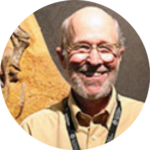Two hundred and twenty-two dried and pressed plant specimens sit in a climate-controlled, windowless room at the Academy of Natural Sciences in downtown Philadelphia. The room is filled with tall metal cabinets that nearly touch the ceiling. Opening the cabinet doors releases the tangy odor of dried, dead flowers. It’s a musty fragrance of age, of decay arrested, of captured moments in the lives of landscapes and collectors long dead. Three of the cabinets contain the Herbarium of the Lewis and Clark Expedition, housed today in the city where in 1803 Meriwether Lewis was sent to be trained for the scientific work of the expedition. The flattened flora specimens are mounted on paper sheets and represent the enduring scientific physical and legacy of the iconic journey across the North American continent 1804-06. This presentation will give an overview of the history of the collection, which spans more than two centuries, beginning with the collection of the plants, and their preservation and study by 19th-century scientists. Meriwether Lewis was the primary plant collector on the trip, charged with learning about the vegetation of the unexplored landscape from the Native Nations living there, writing descriptions in the journals, and bringing back specimens and seeds to his scientific mentor, President Thomas Jefferson. The presentation will also focus on the work of Academy Botanists and conservators at the Conservation Center for Art and Historic Artifacts at the time of the expedition bicentennial, to modernize the materials used to preserve the specimens so that they can be preserved and, on occasion, displayed, for another two centuries and beyond. Customized protective folders, temperature and humidity controls, and other improvements were developed especially for this priceless collection. A video guided tour of the collection will be provided, with commentary by curators and Botany staff.
 DR. RICHARD MCCOURT
DR. RICHARD MCCOURT
Botany Curator
Dr. Richard McCourt has been a Botany curator at the Academy of Natural Sciences of Drexel since1996 and a professor in the Biodiversity, Earth, and Environmental Science (BEES) Department since its founding at Drexel University in 2012.
Professor McCourt's research program targets the biodiversity, evolution, ecology, and systematics of green algae, specifically green algae that are among the closest living algal relatives of land plants. In addition, he curates the plant collection of the Lewis and Clark expedition and has written about the history of the botanical results from their journey. Rick's contributions are widely recognized; he is the author and co-author of over a hundred highly cited articles published in prominent, peer-reviewed scientific journals.
McCourt worked for six years at the National Science Foundation as a program director in the Divisions of Biological Science and Education and Human Resources. He also served as president and chair of the Board of Trustees for the Phycological Society of America and other environmental organizations. Before coming to Drexel, Rick was a faculty member at DePaul University in Chicago; he taught evolutionary biology and ecology courses and mentored graduate, undergraduate, and co-op students in his laboratory.
Rick writes for popular magazines such as Discover and Outside; he has also co-edited the book The New Science Journalists with Ted Anton, a professor of English at DePaul University.
Earlier in his career, Rick worked as a science journalist and reported on science, sports, and arts at National Public Radio. In 1985 he won the AAAS Westinghouse Award for Science Journalism in Radio for a series on aquaculture broadcast on National Public Radio.
